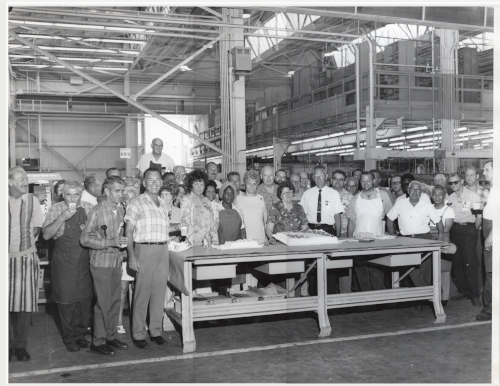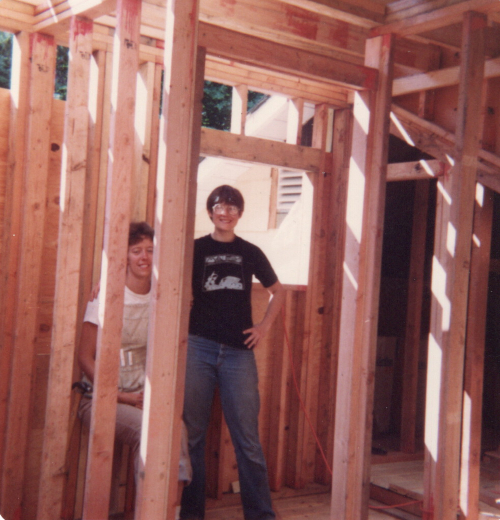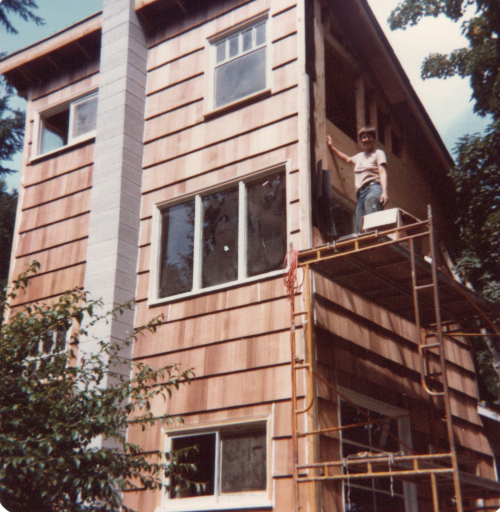WORK
Women in the Trades: A Multi-Generational Tale
By Jean Eberhardt
Anna, my grandmother, was a young single mother to my dad, her only child. She had many jobs—fry cook in a fish shack on the beach, a baker, and then a hotel maid. She answered the call for factory workers during WWII and got a job at Douglas Aircraft in Santa Monica, California.

Women were recruited via persuasive media campaigns to join the war effort as “Rosie the Riveters” to work in the factories that were emptied by the men who were drafted to fight overseas. My grandmother became a machinist in her late 30s and developed a steady hand for guiding hair-thin bits chucked into the drill press through metals. She fabricated specialized tiny parts for war planes and then later for commercial jets.
Anna fought to keep her job after V-J Day in 1945 when thousands of men returned from military service, looking for work. Women were pressured by a national propaganda campaign to “be ladies and return to your homes.” She successfully resisted as she did not have a husband to go home to. Anna eventually retired with 28 years of good-paying union trades work to her name, a solid pension, a great bowling league record, terrible asthma from the particulate matter in the air of the factory, and crippling rheumatoid arthritis in every single one of her joints.
Shortly after my grandmother left the workforce, I graduated from high school in Corvallis, Oregon. I spent the first part of the summer pounding nails and moving construction materials around my friend Tom Denison’s family home remodel. They were adding a second floor onto a Depression-era house outside of town and I was waiting for Agripac (the vegetable cannery in town) to open up late-summer processing jobs to me and other young people.
While I waited for paid work, I had a blast learning how to swing a hammer and be part of a friendly construction crew with Tom, his siblings, and their dad Bill, along with other friends. Their mom, Margo, would make fabulous lunches for us every day. We’d feast and then us kids would head off to the creek to skinny dip. What a life! We’d head on back to the house to keep doing demolition or building and sheathing walls for the rest of the day. Most of my friends planned to head off to college come fall but I had no idea what I’d do after the anticipated August-October cannery run ended.
Bill Denison, a renowned mycologist and believer in young people, asked “Would you like to become a carpenter? You could apply to the union local. They have a training program.” The wheels started spinning in my mind! At that point in my life in 1973 I was an avid, militant bicyclist without a driver’s license. I had confidence in swinging a hammer but no real experience in the design or planning process of building. And I had a desire to keep working with friends and having great lunch breaks (ideally with swimming involved).
I decided to apply for an apprenticeship with the Central Oregon Carpenters’ Union Local 271. It was a drawn out process over several months with an application, a written exam, culminating in a sit-down interview with a couple of skeptical guys. I was the first woman to ever apply there and the first woman that local turned down. I wasn’t crushed. In the meantime, I’d learned that union carpenters in the Northwest worked on commercial sites and built the formwork that would be stripped away after the concrete pours cured enough. I wanted to keep swinging hammers with friends on old houses and have a raucous good time! This became a dream deferred for over five years until the stars lined up for me in Olympia.
After moving here and taking a brief leap into college studies for a few quarters, I stubbornly persuaded Evergreen into accepting my winter 1979 internship learning contract with Janes of All Trades, an under-the-table business created in 1978 by Mic Harper and Helen Thornton, seemingly fearless carpenters transplanted from California. They were in the process of building a habitable dormer on top of someone’s garage out Steamboat Island Road. The academic dean I met with to press my candidacy for a credit-generating internship found my proposal entirely too vocational, so I threw all kinds of feminist, second wave “Rosie the Riveter” arguments at him. I succeeded in moving forward with using financial aid to fund my internship so the Janes wouldn’t have to pay me to learn while they ran their job.
The second wave of young “Rosies” was underway in some cities in the 1970s. My grandmother had recently retired from McDonnell-Douglas Aircraft and would spend the next three decades bedridden in pain, supporting the likes of Ronald Reagan and a couple dozen stray cats, all while hollering at the umpires of baseball games on her television in Pasadena, California. Towards the end of her life and under great physical duress, my brother moved her north to my parents’ home in Corvallis. She had been a proud union tradeswoman. I went the route of being self-employed in a collective.
Confidently strolling into the old, sagging wooden floored Rowland Lumber one day to buy a useful tool for my growing arsenal, I asked to see the kitty paws. I got blank looks in response from the two guys behind the counter. I asked again and the older guy asked what I was looking for. What did it do? I described driving this tool by hammer into the wood under nailheads to then get leverage to pull and remove said nails. They simultaneously started to laugh loudly and suggested that perhaps I meant a cat’s paw? At that moment, I flushed red and realized the friendly banter on the Janes worksite included using an invented diminutive for this demolition tool. I was so embarrassed. I KNEW that a novice dude would never have made that mistake because the guys he worked for weren’t that silly. I bought my first cat’s paw and slunk away.
Three months later, upon the dissolution of Janes of All Trades and the creation of not one, but two licensed and bonded women’s construction companies in Olympia, I dropped out of Evergreen and emerged as a full fledged carpenter dyke! I am still surprised that back in 1979, it was not that hard to get licensed and bonded in Washington, just requiring some front money for the insurance bond and a bunch of paperwork with the feds, state and city. Carol Elwood, Cathy Cox, and I came up with the name NOZAMA Construction for our business, which we thought was side-splitting hilarious. We imagined a small fleet of NOZAMA pickup trucks sometime in the future, with that clever name blazing above the bumpers, reading AMAZON in the rear view mirrors of vehicles in front of us! We got the idea from seeing ECNALUBMA in our rear view mirrors to alert us to move out of the way of an AMBULANCE. This was long before Jeff Bezos co-opted that name of powerful women warriors for his behemoth enterprise. Well, these three aspiring amazons had places to go and houses to rebuild!

NOZAMA’s first big job was wildly ambitious given our lack of experience, but the Evergreen professor Llyn De Danaan was willing to take a risk and give us a chance to succeed. I imagine we presented ourselves with great bravado. Llyn got an all woman crew, we got a lesbo couple for our first clients, and we were off and running!
LLyn says she would watch us through a window after our arrivals, as we stretched with morning exercises for the day ahead. I have no memory of having an audience to our warm-ups. Carol, Cathy and I generated lists of materials from the plans and ordered them, contracted an earth moving equipment operator and stripped off existing siding where we would attach the addition to LLyn’s home. We set the foundation forms and poured the concrete, then stripped the forms and backfilled the dirt. The real fun began when we framed out the substructure and installed the first floor deck. Once we had a dance floor, we built the walls to accommodate salvaged windows. Up went the second floor and walls, and we roughed in the staircase, followed by the loft and roofline. As we closed it all in against the weather, we would look out over beautiful Totten Inlet. A mason came and put up the tall chimney. The two and a half story tower on her cedar shingled home took us novices twice as long to build as we thought it would and I still wince when I think of the mistakes we made, but it still stands and she still lives there. LLyn was a good sport to hire us and we learned a lot.

We were self-taught. We studied books that gave us ideas of what to do on jobs we were hired to complete. We also tapped into the wisdom of those old guys behind the counters of lumber yards across Olympia. Rowland, Hardel, Bayview, and Curtis Lumber all had front desk staff who’d worked in construction until their backs went out or some other injury took them off the job. I’d always had great spatial relationship skills, so I would go in and ask them questions, wave my arms around and start drawing the problems out on scratch paper. Mostly, I found respectful guys who were game for helping me strategize through the situations I brought in. We’d both go at it with pencils to the paper from across the counter. Over time and the forging of those relationships, I began to walk in believing I belonged there. We greeted each other by name and I really appreciated their helpfulness.
Five years in, with Carol and Cathy on to other pursuits, Erin, Rae and I as NOZAMA were hired to raise the roof as well as increase the footprint on Bill and Kaethe’s home on the east side of Olympia at Wilson and Yew. They set up tents for themselves and their two daughters in the side yard, while we ripped off their roofline.
One of our apprentices had a terrible fall through that roof and her arm was gashed open by nail. Mychel, with first aid training to her credit, had to tell us where and how to apply pressure to keep her artery from bleeding out while waiting for the ambulance. It was a sobering experience and, thank goodness, she survived.
It was the rainiest July in recorded history and everything and everyone there got wet. Our elaborate tarping system didn’t work very well, the tents leaked, the stress ran high, it was a mess. We persisted, got the foundation poured for the addition, and built that new, clerestory roofline and the walls to support it. We worked under a really tight budget, which led us to shortcuts that now, years down the road, don’t make any sense. Homemade, single glazed skylights that sweated from condensation, for example. It’s also much more challenging to remodel funky old houses than it is to build new ones. Old walls and floors are almost always out of level and not plumb. Wiring can be dangerously old and rotten roof sheathing can give way.
For years, I felt like an imposter. It took me a long time to realize that plenty of dudes were also learning on their jobs, making mistakes and hopefully learning how to correct them, having accidents, scraping by. NOZAMA didn’t have seasoned mentors to show us the ropes on the job, but we did have the old guys in the lumber yards to strategize with so we could summon up the audacious determination to believe we could do it, then go and actually do it.
Don Martin and John Konovsky hired me to work with them in 1995 to build a large dormer addition on their older home near Squaxin Park in Olympia. Their project involved reconfiguring several walls and all the door and window openings. We also created a wrap-around porch with a clear roof. They set up and lived in a tent in their backyard while we wrestled their old house into shape.
We spoke recently by phone. Don expressed being impressed with my fearlessness. “I couldn’t believe you just took a power saw up onto our roof and cut that giant V-shaped hole into it!”
“Oh, I’m sure I took a lot of measurements and cut the composition roofing off first.”
“All I remember was thinking: Oh my god, this is it.”
“We hired you to do the hard stuff and also to tell us what to do,” John continued. “Don and I did really well with the tasks you assigned us. It’s when we were left to our own devices that we got into fights.”
I responded “Y’know, my work with clients included a fair amount of supporting stressed out individuals and couples through the most taxing remodels.”
“Well, we really needed you Jean. Thank goodness, you squeezed in that last project for us. And hey, we are still together 27 years later!” I so enjoyed the camaraderie of working with and for another gay couple. It was a great note on which to end that 17-year career.
In 1996, I decided with great trepidation to return to college with the goal of plunging into a new direction. I’d become a sole proprietor of NOZAMA over the years, and hadn’t been part of a collective for a long time. I began to feel pretty isolated, especially on the solo gigs, and felt a growing need to find an outlet for my extroverted self to shine. I left construction after working for a lot of great people all over this town and making their homes fit them better. I thought when we began NOZAMA in 1979 that we were on the cutting edge of what would become a huge movement of women in the trades. It’s 2023 now and I’ve yet to see a critical mass of women launch into skilled manual labor.
My grandmother retired from a long trades career where she was recognized for her prodigious skills. I like to think she might have mentored other women in becoming capable machinists too. I can’t believe I didn’t ask her that question or so many others that I now have for her. What were her challenges in learning her trade? How did it feel to fight for respect as a woman in a non-traditional job? What stories could she have told me about fighting for good wages and a pension? How hard was it to keep her job when the war ended and women factory workers were pressured to quit? What did she think of me working in construction? What did she think about the second wave of women (my generation) going into the trades?
Before she died, she gave me her last steel tool box, which still smells of the cutting oil that she used as a drill press operator. It has shallow drawers with calipers, micrometers, tiny clamps, pliers, and the thinnest bits for a drill press from that earlier time in her life.
Decades earlier, she’d engraved her work ID# 16142 on all of her tools as well as her toolbox. Years ago, I marked my wrenches, squares, tape measures, chalklines, levels, utility knives, hammers, and even that first cat’s paw with dabs of green and purple paint to identify my tools. I didn’t paint all the power tools. I hauled around a lot of my carpentry hand tools in a heavy, old leather toolbox originally built to house surveying equipment. Both boxes now sit on shelves, infrequently opened for small project work around my home.
I do wonder to whom I’ll leave my grandmother’s steel tool box and my leather tool box. Also, will I live to see a significant third wave of Rosies, of women in the trades?
WWe encourage readers to contact us with comments and corrections. Disclaimer
